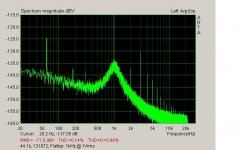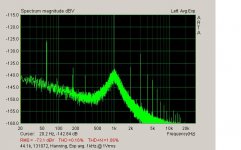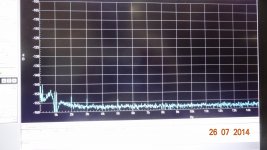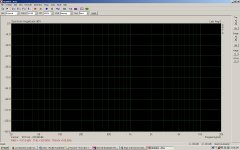If you have a reasonably pure tone that is centered in a bin of a known value I would think they will all give about the same number. Its a number that can be measured with a conventional meter to pretty high accuracy.
Differences can also be due to drift, a problem with large (1M point+) FFT's where the signal moves from bin to bin during the measurement.
Differences can also be due to drift, a problem with large (1M point+) FFT's where the signal moves from bin to bin during the measurement.
Well, you see in the pictures at #3916, above, exactly what I see with the two win filters. I might actually have to call A-P to explain it.
THx-RNMarsh
I see that. However the noise should drop not the harmonics. At least not that much.
There is small differences in what I posted. Those difference are inline with what's predicted for those two windows.
What I need to see are the harmonic level numbers measured by the ShibaSoku AD725D and compare as it is known to be extreamly accurate. Use its monitor output. Which ever win filter matches the levels of the 725 is what I'll go by. Not very elegant but useful for the time being.
Meanwhile, take a look at this - especially the 3rd paragraph: More needs to be understood before we can accept, with confidence, a budget measurement approach to these extreamly low levels of distortion;
View attachment FFT WINDOWs.pdf
THx-RNMarsh
Meanwhile, take a look at this - especially the 3rd paragraph: More needs to be understood before we can accept, with confidence, a budget measurement approach to these extreamly low levels of distortion;
View attachment FFT WINDOWs.pdf
THx-RNMarsh
Last edited:
See page 4 of this paper for some info on windowing filters and amplitude accuracy:
http://www.thinksrs.com/downloads/PDFs/ApplicationNotes/AboutFFTs.pdf
http://www.thinksrs.com/downloads/PDFs/ApplicationNotes/AboutFFTs.pdf
Coherent sampling requires precision and stability not possible with an RC oscillator. If you lock it to a clock linked to the ADC you can get there if the locking doesn't add too much distortion. The melt noise feature of the QA400 does the coherent sampling thing if you want to try it.
I modded a KH4400 for this and it works but open loop it does not. Triggering the sampling on the oscillator won't work. The trigger is not perfect enough.
I modded a KH4400 for this and it works but open loop it does not. Triggering the sampling on the oscillator won't work. The trigger is not perfect enough.
Coherant sampling with no win (rect win).
What's the setup for this plot? As far as I know there's no way to get the "corehent sampling" mode to work correctly with a notched signel--you need the fundamental for this.
The "flat top" window is the best to use for THD measurements as it gives the lowest (IIRC a fraction of a dB) amplitude error of all windows available in the SYS-2722. It has poor side-lobe behaviour, but that's no issue as the dynamic range is low after the notch filter.
Samuel
I think you would need the oscillator to d coherent. Not just a record.
Fin/FS = Mcycles /Nsamples must be even number. Otherwise it spits out with a fractional part.
All the calculators I found on the net are in MHz and don't work in reverse.
The one from Maxim accepts fractions.
Fin/FS = Mcycles /Nsamples must be even number. Otherwise it spits out with a fractional part.
All the calculators I found on the net are in MHz and don't work in reverse.
The one from Maxim accepts fractions.
Davada,
an obtuse little point (bad pun)
#3921
the names are Hamming and Hann
they were both last names of people
no such person as Hanning was a mathematician
Cheers
Alan
Well I stand corrected.
Apparently ARTA got it wrong too.
Thanks.
Attachments
Last edited:
What's the setup for this plot? As far as I know there's no way to get the "corehent sampling" mode to work correctly with a notched signel--you need the fundamental for this.
The "flat top" window is the best to use for THD measurements as it gives the lowest (IIRC a fraction of a dB) amplitude error of all windows available in the SYS-2722. It has poor side-lobe behaviour, but that's no issue as the dynamic range is low after the notch filter.
Samuel
See A-P's 2700 Series user's manual (575 pages
I would think the sampling would be locked onto the signal before the notch. but, Hey! What do I know. I used the HiREs A/D @SSR for input setting, if that helps.
All previous data was with Flat Top. It shows higher than Demian and David's levels. That is the issue to understand.
THx-RNMarsh
Davada,
an obtuse little point (bad pun)
#3921
the names are Hamming and Hann
they were both last names of people
no such person as Hanning was a mathematician
Alan
Alan, also an tschuss point, probably want to let
SRS know about that. They shouldn't publish
with such obvious errors in their technical papers.

I did notice when I ways trying to have a multitude of measurements
when I added SNR to the mix, the QA400 started going bonkers. Most
of the LEDs started blinking on and off etc.
I also was curious as to why the different measurements would bring
varying results. Why with just a click of the button I got about 10 dB
better results.
While I'm not an engineer I like the tools and instruments I use to be
good, reliable, affordable. I don't have the money to buy the top of the
line stuff or even second, thrid tier gear. I'm relagated to buying
surplus gear from thrid parties.
I'm way over budget on what I thought I would need to spend
on the stuff that I have now. Thankfully, that is not too much, but
I do make mistakes and that can be costly. I can also sell some
personal stuff that I don't use, which helps fund my DIY projects.
And, I hope to spend the minimal amount necessary and do the rest
of the work myself to get the most bang for the buck instruments
with the greatest amount of flexibility for testing and measuring
my various types of gear.
Last edited:
however hp and agilent have never made the error nor AP or Tek.
I know because I have been corrected.
Cheers
Alan
(of course never is a very powerful term!)
Julius von Hann, father of modern meteorology, (23 March 1839 – 1 October 1921)
http://en.wikipedia.org/wiki/Julius_von_Hann
Richard Hamming (February 11, 1915 – January 7, 1998)
http://en.wikipedia.org/wiki/Richard_W._Hamming
I know because I have been corrected.
Cheers
Alan
(of course never is a very powerful term!)
Julius von Hann, father of modern meteorology, (23 March 1839 – 1 October 1921)
http://en.wikipedia.org/wiki/Julius_von_Hann
Richard Hamming (February 11, 1915 – January 7, 1998)
http://en.wikipedia.org/wiki/Richard_W._Hamming
Last edited:
- Home
- Design & Build
- Equipment & Tools
- Low-distortion Audio-range Oscillator



